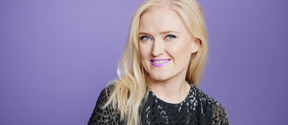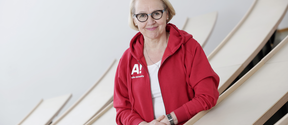Fepod: a medical startup's innovation helps to optimise pain medication doses
We spoke with Elsi Verrinder, Fepod CSO and co-founder, about the medical startup's bid to optimise pain medication for all patients, plus her experience as a PhD student at Aalto University.

Willow bark. Mandrake. Opium. Over the centuries, we've explored countless treatments to soothe pain.
And we've got better at it over time. Now pain medications like paracetamol, codeine and morphine are commonplace. But are they optimal? Elsi Verrinder, co-founder and CSO of Fepod believes we still have some way to go.
Fepod’s innovation - a device that quickly assesses the concentration of pain medication in the blood - helps medical practitioners determine whether a patient's dosage is sufficient to provide relief. It also reveals when too much pain medication has put them at risk of an overdose.
We spoke with Elsi about her journey from Aalto PhD student to medical tech startup CSO.
Hi Elsi, can you tell us a little about Fepod?
Sure! Our startup Fepod has developed a handheld point-of-care system. It works by measuring concentrations of pain medicine within the blood to make sure the dosage is optimal for the patient.
The system works with just a small drop of blood and the results are almost instantaneous.
We'll be making the Fepod system available for healthcare institutions and hospitals. Because the device is so compact, it's very portable, so it can also be used by paramedics and for roadside drug testing.
What problem does Fepod solve?
Like most drugs, pain medication has 'standard' doses, usually based on a patient's weight. But we've found that those doses are only suitable for some. Because of the differences in everyone's physical makeup, what's right for one person might not be enough for another - or might even be too much.
The best way to determine whether a patient has received an optimal dose is to measure blood concentration levels - but until now, there's been no fast or easy way to do that. Drawing blood samples, sending them to the lab, analysing them, and waiting for the results - this can take at least an hour, and usually way more.
When a patient is in pain, it is often unbearable. With the Fepod system, finding optimal pain medication takes minutes, not hours.
How does the Fepod system work?
We take a pinprick blood sample which is inserted into a test strip that employs a carbon-based material as a key component. An electrochemical reaction is then measured by a device called potentiostat, and controlled, analysed and displayed through our mobile app.
The results are quickly displayed using our bespoke software. The potentiostat, which is only slightly bigger than a mobile phone, is ultra-portable and connects to a user's smartphone to display results.
How did Fepod get started?
In 2017, I started my PhD focusing on electrochemistry at Aalto University (having previously completed my Master’s degree there).
At Aalto we formed a group with other students and researchers to receive six months' funding from Business Finland to develop a proof of concept for a new research idea. As a group, we we had years of experience on on developing a carbon-based sensor system to detect neurotransmitters in biological samples.
At the time, the opioid crisis in the US was making headlines. Opioids are similar to neurotransmitters in that they are very small and hard to detect, and their chemical structures are similar. So, we pivoted to using electrochemical responses to detect the presence of opioids in the blood.
We received a further two years of funding from Business Finland to develop the concept further through research, and then an additional two years' funding to transform our research into a viable business.
The founding members of the group are still very much involved in the business as CTO, CIO and myself as CSO.
We are all very much scientifically and technically minded, so with our funding we were able to hire a marketing expert who is now our CEO.
What's next for Fepod?
We've concluded two clinical studies in Finland. In 2023 we will seek further validation for our solution with more clinical studies in the EU and the US.
I'm happy to say that we recently secured seed funding of €0.8M, which will see us continuing with further research and development to fine-tune our solution, as well as recruiting more skilled team members.
We hope that our device will soon be in use in medical institutions in the US and EU.
What was your experience like at Aalto?
I've always felt very much a scientist at heart. I never saw myself as a startup founder, or really anything to do with business.
But during my time at Aalto, I realised that I didn't need to be a business expert to create a successful business. Collaborating with others while focusing on my own area of expertise has been so fruitful.
I was able to meet a lot of people from different disciplines and to share learnings.
My dream has always been to contribute to the medical field through engineering - during my PhD I realised that I was doing exactly what I'd set out to, and there was something very fulfilling about that.
Aalto University's entrepreneurial community is helping startups like Fepod to thrive. Want to kick off your own entrepreneurial journey? Check out the Starting Up course. The open access online course covers the fundamentals of startup entrepreneurship. If you want to learn more about founding your startup with Aalto, explore the Aalto Startup Centre.
Show other posts from this blog

Upright: Enhancing the understanding of the true impact that companies have on the world
Especially the largest companies in the world have come to realise that measuring net impact is now an issue of “do or die.”
Kirsi Niinimäki celebrates the textile revolution and chooses 10 as her number
I’m very excited about the speed and volume of the progress that’s happening. It seems that everyone wants to switch to the new model.
Kristiina Kruus is inspired by a technology of hope - and chose nine as her number
Instead of releasing carbon dioxide into the atmosphere, we can capture it and turn it into things like fuel or a protein-rich cell mass.